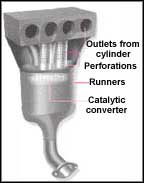Cleaner and efficient
 CAN some holes drilled into the exhaust system of a car engine increase power and lower emissions? Yes, says Ahmet Selamet of the Ohio State University in Columbus, usa. He has been working along with engineers at the Ford Motor Company near Detroit on problems car engines have in pushing out gases into the exhaust manifold. The exhaust manifold comprises converging pipes that carry exhaust gases away from the cylinders towards the catalytic converter. While entering the manifold, gases create back pressure, which decreases a car engine's efficiency. Also, the pressure formed as gases emanate from the cylinders generate a lot of noise, which can be up to a deafening 190 decibels, requiring complex muffling systems.
CAN some holes drilled into the exhaust system of a car engine increase power and lower emissions? Yes, says Ahmet Selamet of the Ohio State University in Columbus, usa. He has been working along with engineers at the Ford Motor Company near Detroit on problems car engines have in pushing out gases into the exhaust manifold. The exhaust manifold comprises converging pipes that carry exhaust gases away from the cylinders towards the catalytic converter. While entering the manifold, gases create back pressure, which decreases a car engine's efficiency. Also, the pressure formed as gases emanate from the cylinders generate a lot of noise, which can be up to a deafening 190 decibels, requiring complex muffling systems.
Selamet's solution is what Ford calls perforated manifold, muffler and catalyst exhaust system. The manifold is enclosed in a sealed casing with redesigned tubes. These tubes, also known as runners, smoothly guide the gases away from the engine. This happens because each tube is perforated with about 300 holes, each of which is less than three millimetres in diameter. A very small amount of gases escape from the runners into the outer casing. This alleviates the pressure waves.
The perforations make it seem that the gases are expanding into a much larger volume, Selamet points out. In tests, the engine power was boosted by three per cent to five per cent by the new manifold a significant increase. Most of the emissions come in the first few minutes of driving, before the catalyst (in the catalytic converter) heats up,' Selamet observes. To solve this, he moved the catalytic converter much closer to the engine than is usual. This quickly heats up the converter.
Tests on a 1.9-litre Ford Escort engine revealed that emissions of oxides of nitrogen, carbon monoxide and hydrocarbons were reduced by 9, 16 and 27 per cent respectively.
Related Content
- Efficient grid-interactive buildings: future of buildings in ASEAN
- Transitioning India’s road transport sector: realising climate and air quality benefits
- World energy transitions outlook 2023: 1.5°C pathway, Volume 1
- Order of the National Green Tribunal regarding ambient air quality in the Indo-Gangetic plain, 27/03/2023
- The economic benefits of early green innovation: evidence from the automotive sector
- Renewable energy outlook for ASEAN: towards a regional energy transition
